Consordinis articles are written by musicians who independently research, test, and recommend the best instruments and products. We are reader-supported. When you purchase through links in our articles, we may earn an affiliate commission.
Podcasting is fun and popular, with thousands of new podcasts released every single week, but without quality audio, listeners will switch off. So, we’ve created a list of reviews of models that, if used correctly, can sound fantastic.
Here are the best podcast microphones 2025:
- Audio-Technica AT2020USB+
- Shure SM58
- AKG C214
- Samson Meteor Mic
- MXL 770
- AKG Lyra
- Blue Snowball
- Behringer Ultravoice XM8500
1. Audio-Technica AT2020USB+
The best mic for podcasting
The Audio-Technica AT2020 is a very popular microphone, which does a brilliant job of providing clarity at an affordable price tag. This is the USB version of that microphone, which means you can totally bypass a mixing desk or other equipment such as an audio interface.
The AT2020USB+ can be bought as either a standalone microphone, or you can buy it as a pack for podcasting or streaming. This means you have a boom arm that you can place on your desk and move to a comfortable position, leaving your hands free. You can also get an ATH set of headphones included.
It’s a condenser microphone, and works with 44.1 or 48 kHz sampling rates. One of the best things about this model is the fact that it has a headphone jack inbuilt for live monitoring, meaning you can hear what you are recording with no delay or latency.
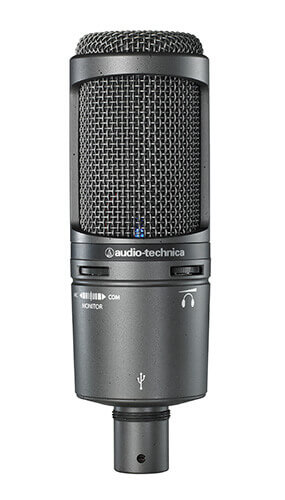 Image credit: Audio-Technica
Check Price on Amazon
Image credit: Audio-Technica
Check Price on Amazon |
|
If you know that you want your microphone to be used just for podcasts and streaming through your computer, this can be a very good option, and is top-rated when it comes to reviews. It provides professional results at an affordable price tag.
2. Shure SM58
The best dynamic microphone for podcasting
Dynamic microphones are a bit more sturdy and hard-wearing, but sometimes not quite as high-fidelity as condenser microphones. However, the Shure SM58 and SM58S (with a vocal switch) are the king of the dynamic mic. They are incredibly versatile, represent good value for money and can be used as a podcast microphone.
One of the reasons this microphone is great for use as a podcast mic is the fact that it is tailored specifically for the frequency range of vocals. The midrange is bright and there is a bass cut, so you don’t have to worry about the proximity effect.
The shock-mount system cuts handling noise, and there’s even an inbuilt pop filter, so you can get some very high-quality recordings of voices with this microphone, whether on a boom stand or other stand. The only real downside of this mic is the fact it doesn’t have any USB connection, so you will need to use an audio interface or mixing desk to connect this to your computer.
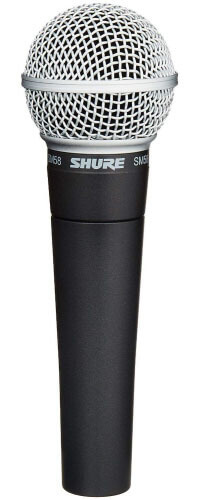 Image credit: Shure
Check Price on Amazon
Image credit: Shure
Check Price on Amazon |
|
This microphone is built for vocals. You will probably recognize the design from watching live performances. Shure is a reliable manufacturer and the SM58 is a great podcast mic, especially if you already have the audio interface to use it. It’s available for around $100, so you may still even have budget left for an audio interface.
3. AKG C214
A high-end studio podcasting microphone
The AKG C414 and C214 are great options for podcasting. The C414 is an iconic microphone, which does a great job on vocals and a variety of other instruments, and the C214 is a more modern alternative, designed to pick up the same frequencies, but it costs a little less.
It still counts as a high-end microphone, in our eyes. AKG have packed an awful lot into this package and it is capable of making some incredible recordings if you use it right. Even audiophiles will love this mic.
If you do want to get the elite version, the C414 XLII might be worth the extra investment. The C214 can be chosen with a specific frequency response which is good for vocals, which is slightly less versatile, but it is great for recording voices.
A few more tech features make this suited to podcasting, it’s got a 20 dB attenuator and a bass-cut filter, so that close recordings will avoid the proximity effect, something many podcasters can find frustrating. It also has suspension, acting like a shock-mount to avoid mechanical noise.
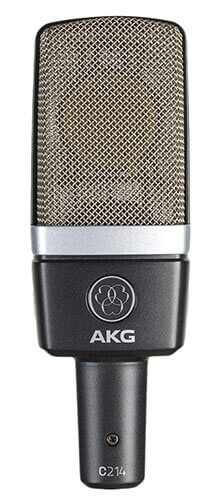 Image credit: AKG
Check Price on Amazon
Image credit: AKG
Check Price on Amazon |
|
If you are looking for a higher fidelity microphone and don’t mind spending a little extra for a brand name like AKG then there are a lot of reasons to look to a mic like this. If you record vocals or instruments, too, this can be a powerful tool. The integrated suspension is great for mounting this mic on a boom stand and avoiding mechanical noise or vibration noise, perfect for podcasting.
4. Samson Meteor Mic
A portable USB option
Some podcasts are recorded on-location, and it can be hard to take your full studio setup with you. A portable setup can be achieved with a mic like the Samson Meteor Mic, which has been designed to work with almost any modern laptop, and fit inside a tiny pouch, so you can take it out with you. It can even fit inside your laptop bag.
The legs that act as a stand fold up to form a part of the microphone, so you don’t need to take anything with you, just the mic and your laptop. With the right adapters, you could even use this with your iPad or tablet.
The sound quality is pretty good, without being stunning quality. It wouldn’t be the mic of choice for a pro studio, but for a portable option it can give a simple and easy option for recording.
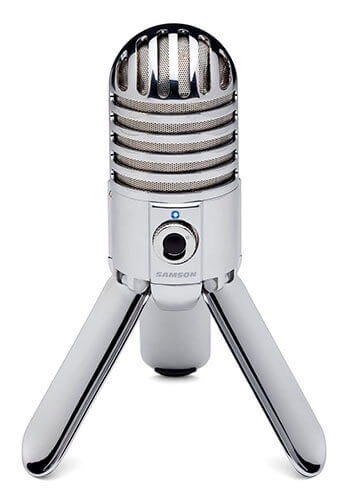 Image credit: Samson
Check Price on Amazon
Image credit: Samson
Check Price on Amazon |
|
If you are looking for something small, portable and relatively affordable, the Meteor Mic could be a good choice. The audio clarity is good rather than being amazing, but it is certainly good enough for beginners and hobbyists.
5. MXL 770
Value for money
MXL microphones are incredible value. In spite of being pretty affordable, they have some brilliant features and functionality, and the sound quality is impressive. If you were to blind test the microphones then you could easily mistake this for a $300 microphone, but it is actually under $100.
It’s been designed with a lot of features that are great for streaming and podcasting including a low frequency roll-off to get rid of the unwanted low-end rumble known as the proximity effect.
This is a condenser microphone, so you do need some sort of way to provide phantom power to it, this can be done using an audio interface or a small mixing desk. Once you provide this phantom power, the clever, patented design uses an FET preamp with a transformerless output for surprisingly clear and professional audio.
To be one of the highest-rated products it could arguably be improved with an inbuilt shock mount, but it does come with the MXL-70 Shock Mount. Keep your mic in this to avoid noise if you are going to move it around during recording.
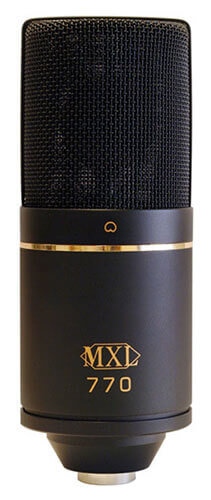 Image credit: MXL
Check Price on Amazon
Image credit: MXL
Check Price on Amazon |
|
Value is the main word we’d use to describe the MXL microphone, but it does require a phantom power system such as a mixer, so you might find that it costs a little bit more to complete your podcasting setup if you don’t own this. No USB model is on offer currently.
6. AKG Lyra
The best podcast mic for interviews
The way people use microphones is changing, and one of the best things about this is the fact that manufacturers are making new microphones to help with different purposes. The AKG Lyra is an example of the changes that are being made by some of the top manufacturers, and it is designed to make it easier to perform podcast interviews.
Four capsules means that there are lots of different pickup modes. You can use the capsules to record audio from both sides, meaning interviewer and interviewee being picked up at the same volume, and being able to perform an interview with one mic instead of two.
Adding to the convenience is the integrated desktop stand, which you can use for recording, or, for solo podcasts you can mount to a boom mic. The plug and play technology means that you can connect via USB-C and be ready to use with your computer or even with a tablet.
The audio is ‘ultra HD’ meaning 24-bit, 192 kHz recordings, a higher bitrate than many other USB microphones.
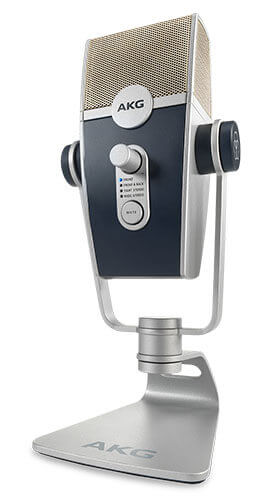 Image credit: AKG
Check Price on Amazon
Image credit: AKG
Check Price on Amazon |
|
If you are looking for a single mic that can handle group interviews or one-on-one podcasts, this can be a great purchase and avoids the need to purchase multiple mics. You don’t need a confusing setup, just plug in the one microphone and you are ready to go. You can change the settings to simply record one voice if needed.
7. Blue Snowball
A good cheap USB mic for podcasting
If you are looking for an affordable USB microphone then the Blue Snowball mic might be the ideal choice. It’s a very good choice, in spite of not costing a huge amount of money. Blue mics have been something of a game changer in USB microphones, they started manufacturing some of the first really popular USB models including this and the Blue Yeti.
If you want to spend a little more, the Blue Yeti is an option with a few more features and a better inbuilt stand.
The Snowball looks more like a security camera than a microphone, but don’t let this put you off. A two-capsule design can be good for cardioid recordings or in an ‘omnidirectional’ mode to record sounds from around the microphone. You can easily switch between these settings. Multiple recording applications and switchable patterns makes this a very good choice in terms of versatility.
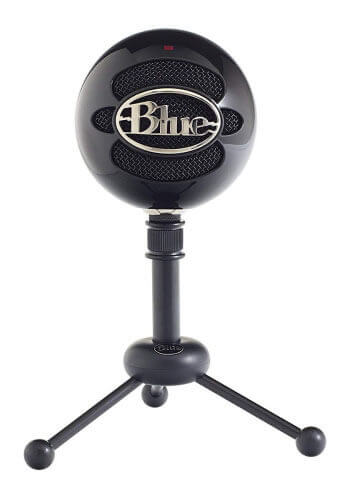 Image credit: Blue
Check Price on Amazon
Image credit: Blue
Check Price on Amazon |
|
For a USB mic that is relatively budget-friendly, this could be a great choice. In an ideal world, gain controls and live monitoring via headphones would be an improvement. It is relatively portable, too, so not hard to put in your portable setup. Blue mics have a good reputation and their range of USB mics is growing.
8. Behringer Ultravoice XM8500
A very affordable dynamic mic
Behringer is a brand name with some mixed reviews, and some mixed products! Some of their microphones and other products aren’t the best. Some audio engineers see the Behringer brand as a bit of a curse word. The truth is that they are a budget audio manufacturer, and some of their products are pretty good for the price. If you aren’t too worried about the brand name, and are looking for a cheap dynamic mic, the Ultravoice XM8500 is a good choice.
It is important to be realistic about what is on offer for this sort of price range. For example, the frequency response only goes up to 15 kHz, whereas many of the best podcast microphones can record up to 20 kHz.
It does have a cardioid pattern that allows you to reject unwanted noise and feedback. It also has an inbuilt pop filter, so there won’t be as many breath and pop sounds within your recording.
You’ll need an audio interface to record from this microphone, but not phantom power as it is a dynamic mic. For under $50, you will struggle to find better value from your podcast mic.
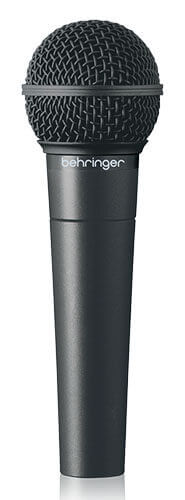 Image credit: Behringer
Check Price on Amazon
Image credit: Behringer
Check Price on Amazon |
|
It’s not one of the most elite microphones on offer. You won’t see this on the Joe Rogan podcast or other top podcasts any time soon, but if you are just getting started and need cheap microphones that will do a good job, Behringer may have you covered with their Ultravoice XM8500. It’s a stripped down, cheaper version of the SM58, in effect.
How to choose a mic for podcasts?
USB or not?
USB mics have had a bit of a bad reputation over the years, but honestly, in the modern age the technology has improved to the point where USB mics can do a good job. For podcasting, it is an ideal situation, and you can simply plug in the mic and be ready to go.
If you are using multiple microphones, for interviews or group podcasts, it can be really difficult to use USB mics, so it might be worth getting a multiple-input audio interface. This can allow you to use dynamic or condenser microphones to record the audio. Audio interfaces can connect to your USB input, so it isn’t too much more difficult to set up.
The proximity effect
Many of the best microphones for podcasts are designed with some way to tackle the proximity effect. This is what happens when you move the mic close to the source. The bass frequencies are often boosted. Microphones can account for this by removing some of the low frequencies. It is advisable to record from an audio source that is six inches away or more, but not too much further.
Stands and boom arms
Most of the big podcasters out there use boom arms, especially if being recorded at a desk. This is a fantastic way to have a lot of freedom and flexibility. Boom arms usually include a shock mount so even if there’s a bit of a jolt the noise shouldn’t be too much of an issue, the mic may not pick it up at all.
Many of the microphones on the list, especially the smaller USB mics, have a stand included. Some of these, like the Meteor Mic, are folding stands. These stands are convenient, but you use them on a table, you need to be very careful of jolting or knocking the mic. If you do this mid-interview, you could lose some of your precious audio, and this can’t be fixed.
Cost
How much should you spend on a podcast microphone? In truth, some of the cheaper options don’t sound amazing. A $50 mic might get you started, but if you can invest $100-200 you might get a lot more functionality and close to professional sound.
You could spend thousands of dollars on a podcasting mic. Fortunately, you don’t need to spend this kind of cash in order to get a high-quality recording. Many of the best options on the list are still under the $200 mark.
Conclusion
The market for podcast microphones continues to grow, just like the podcast market. There are some brilliant options to suit almost any budget, just be sure to consider your own needs, and whether you need it to be portable, or have USB functionality, before you make a purchase. Our podcast mic reviews should help you to make the ideal decision for your needs.